Episode 182
What you’ll learn in this episode:
- The difference between jadeite and nephrite, and why both are known as jade
- Why Chinese artisans have chosen to carve jade for thousands of years
- Why jade can be purchased at dramatically different price points
- How to spot a pseudo jade that has been dyed or polymer treated
- Why a healthy sense of skepticism is the most important thing a new jade collector can have
About Eric Hoffman
Eric Hoffman is an aficionado of Chinese jades for over 40 years. He is the owner and operator of Far East Gallery, which is dedicated to lovers of Chinese arts, antiques, antiquities, and—most especially—jades and snuff bottles. A member of the worldwide organizations Friends of Jade and the Association for the Study of Jewelry and Related Arts, jade consultant to the Chinese Cultural Relics Association, and contributing editor to Adornment magazine, Prof. Hoffman has written many articles and reviews on this fascinating subject.
Additional Resources:
Introductory Articles on Jade:
http://hoffmanjade.com/Adornment_Jade.pdf
https://asianart.com/articles/hoffman/index.html
Photos:
Lavender jadeite, jadeite, and diamond “flower” brooch, photo credit Sotheby’s Hong Kong
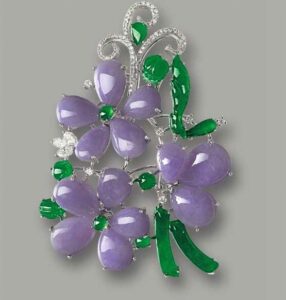
Icy jade Buddha pendant, photo credit Gems & Gemology (GIA, 2014) and Zhaoyi Xintiandi Co. Ltd
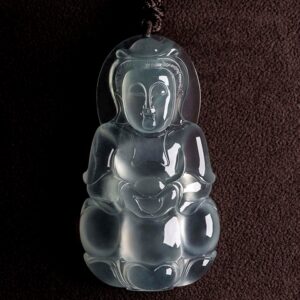
Mawsitsit ring (2016 Spectrum Winner), photo credit Mark Schneider Design
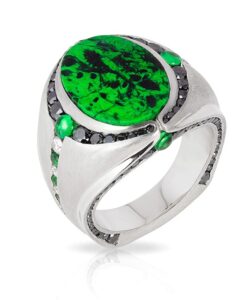
Reticulated jadeite bead necklace, late Qing dynasty, photo credit Wang Collection
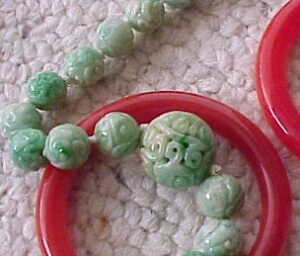
Platinum, jadeite, and diamond brooch, c. 1930, photo credit Sotheby’s
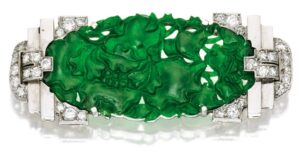
Transcript:
Jade is a popular gemstone that even the most avid jewelry collectors often know little about. Much of the confusion stems from the fact that two distinct stones share the same name. Enter Eric Hoffman, a jade dealer and author who is an expert on identifying different types of jade. He joined the Jewelry Journey Podcast to talk about jadeite jade vs. nephrite jade; why jade can either be extremely valuable or basically worthless; and how new collectors can find quality pieces. Read the episode transcript here.
Sharon: Hello, everyone. Welcome to the Jewelry Journey Podcast. This is the first part of a two-part episode. Please make sure you subscribe so you can hear part two as soon as it’s released later this week.
Today my guest is Eric J. Hoffman, who’s extremely knowledgeable about jade. Eric is the owner of Far East Gallery and HoffmanJade.com. He is both a seller and a buyer, and he knows a lot about what makes jade valuable. He’s also an author who has written about jade. I don’t know about you, but I know nothing about jade. So, Eric is going to tell us about his path, tell us about jade, and educate us about collecting the gem. Eric, welcome to the program.
Eric: Thank you for inviting me to talk about my favorite subject.
Sharon: Thanks for being here. Tell us about your journey. I know you didn’t start out in jade. You started out in a different field, but how did you get into jade?
Eric: I definitely did not start out in jade. Around 1970, I was on the bench designing communication circuits for satellites. My technician was an amateur minerologist, a rockhound, and he dragged me off one weekend to a gem show in Pennsylvania. At the show, they had a gem-carving contest. This was pretty much the first time I realized you could carve gemstones.
The winner of the contest was a gorgeous cat sitting on its haunches, about six or seven inches tall, carved out of tiger eye. It was on a platform that was rotating under a spotlight, so you got all the play of color off the tiger eye. It was an incredible thing to see, and it really got me interested in carved gemstones. It didn’t take too long to realize the best stone to carve was jade, and the best carvers at carving jade were the Chinese. They’ve been at it for 8,000 years. That’s how I got started.
Sharon: Tell us about jade. You mentioned you have a gallery and that you’re a dealer. I have a lot to ask you. Tell us a little about jade itself.
Eric: Jade is a very interesting gemstone. There are a lot of gemstones that go by multiple names, but I think jade is the only example where two different stones go by the same name, jade. There’s nephrite jade and there’s jadeite jade. Both of those are carved. The jadeite is more commonly seen in jewelry and the nephrite is more commonly seen in carvings and artifacts.
Sharon: So when I hear or see something about nephrite, it’s jade, no matter what you’re saying.
Eric: That’s right. Both nephrite and jadeite are properly called jade. There are a lot of jade imitators around that are not jade, but those two stones are.
Sharon: What are the differences between nephrite and jadeite? When I read about jadeite, I don’t know the difference. Is that jadeite is or is it jade?
Eric: Nephrite jade is the historically first jade. It’s the jade that has been carved for 8,000 years by the Chinese. It’s a calcium magnesium silicate, and the thing that makes it unique is that it’s the toughest of all the stones. It’s the hardest to break of all the stones.
Jadeite, which has very similar properties, is a sodium aluminum silicate. It’s a different stone. In fact, both of these stones are rocks. Technically they’re mixtures of minerals, but we call them rocks. The thing that makes nephrite so tough is its fibrous structure that’s matted together, like the fibers in the felt in a felt hat, which makes it extremely difficult to break and allows carvers to work it very thin.
Sharon: Is white jade nephrite? What is white jade? Where does jade come from? It’s in the ground, but is it in the same place in the ground? Does somebody do something with it afterward? Do they add a chemical or something?
Eric: They’re found in very different regions. Actually, they’re found all over the world, but most commonly the nephrite that the Chinese were using, at least for the past 1,000 years or so, has come from a region in western China called Hotan. The jade you’re likely to encounter in jewelry is jadeite. It comes from the northern part of Burma, and it was only in the late 1700s that it became commonly seen in China.
Sharon: When you say it’s been carved for thousands of years in China, the nephrite jade that’s in the Hotan region, what was it about this stone that attracted carvers and kept it going for so long?
Eric: The initial thing that attracted the Chinese carvers 8,000 years ago—this was even before metals came into common use in China—was the extreme toughness of jade. It could be used for hammers, axes, adzes, chisels, tools, weapons. It was like the high-tech material of its day 8,000 years ago.
Sharon: When you say that other people are carvers, I think of objects. Was it made into objects also?
Eric: It started out being made into functional objects, tools and then weapons. But it was in such high regard that it soon became kind of a kingly material used in the royal court, and it started to pick up significance other than being a practical material.
Sharon: When people started to want jade jewelry, they moved to the other kind, jadeite.
Eric: The jewelry that was used in the ancient days is not something we would probably wear today. They tend to be more like plaques worn from robes, maybe suspended from a belt. Around the late 1700s China got control of the northern part of Burma, which was a warlike tribal area, and that’s where jadeite is found. Jadeite had brighter, more attractive colors than nephrite, so it immediately caught on for jewelry in China.
Sharon: Tell us about your business with both kinds of jade, I presume. Will people pay more for the nephrite from your gallery? Will you pay more knowing you can resell it for more?
Eric: I didn’t intend to get into business. What happens if you’re a collector is you always want some particular object, so you buy the first one that comes by. Then a better one comes along maybe a year or two later, and now you’re struck with two of them. I’m constantly selling the extras and using any proceeds to acquire new items.
Jade can be a very expensive stone. We normally think of jade lumped in with the semiprecious stones, but in the highest grade, jadeite and red diamonds are the two most expensive, valuable gemstones. An extreme example of that would be the famous Barbara Hutton jade necklace, which is 27 spherical beads of jadeite. It sold a few years ago at auction for $27 million, $1 million per bead.
Sharon: Wow! Which is stronger? Are they both as strong, the jadeite and the nephrite? Can you throw both of them against a wall?
Eric: Nephrite is the tougher stone by a little bit. As I said, it’s the toughest of all the stones. In fact, it may be toughest natural substance in the world. I’m not certain about that, but it’s certainly the toughest of the stones, the hardest to break. Jadeite is a little less tough but a little bit harder, so it makes a better ring stone, for example.
Sharon: How long ago did you decide to start an online gallery, Far East Gallery and HoffmanJade.com? You’ve coauthored books about jade. How long ago did your collecting become more of a business?
Eric: Far East Gallery goes all the way back to the early 70s, which precedes the world wide web and the internet. As soon as the web arrived, I started a web-based business, which is worldwide at this point.
Sharon: You said there was something you had planned for online, another web page or more information.
Eric: Just a few days ago, in fact, I added a page on jade jewelry. This was at the urging of my wife, the jewelry historian.
Sharon: That’s Elyse Karlin, I should say.
Eric: Elyse Karlin, whose computer I’m using right now. Other than that, the website consists of jade objects, some of which can be used for jewelry and snuff bottles, which is another side interest of mine.
Sharon: When I see a piece of jewelry and the person I’m buying it from says it’s jade, should I ask if it’s nephrite or jadeite? Should I assume it’s jadeite or nephrite? I don’t know what I should do.
Eric: It always pays to ask. If it’s a carving, it could be either. If it’s jewelry, it’s probably jadeite, but there is also nephrite jewelry.
Sharon: I think I told you that I was in Santa Fe, New Mexico a few years ago before Covid, and somebody was trying to sell me Mawsitsit earrings. I had never heard of Mawsitsit. They told me it was a very unusual kind of jade and it was going to overtake jade in a sense. Since I knew nothing about it, I didn’t know if they were giving me a line. Tell us about Mawsitsit.
Eric: If it was a good price, you probably should have bought them. Mawsitsit is a very interesting stone. It’s kind of a cousin of jadeite. It has a lot of jadeite in it, but also some other components such as kosmochlor and other minerals. It’s found in only one tiny, little region in Burma. It’s sort of a vivid green with black streaking through it.
Sharon: If I remember—this was years ago— it was sort of black with blue and green. Is Mawsitsit something special? If I talked to a person who really knows jade and I say Mawsitsit, do they know what I’m talking about?
Eric: I would say probably yes. It’s a desirable stone in its own right, although it is technically not jade. It has a lot of jadeite in it.
Sharon: I think it’s the first and only time I have ever encountered this stone. When you say it’s harder than any known natural substance, is it harder than diamonds? You usually think of diamonds as the hardest thing there is.
Eric: Actually, what I said is it’s tougher, which means it’s harder to break, but it’s not especially hard. Hardness is the resistance to scratching, and of course diamond is at the very top of the scale. Nephrite comes in at about a 6.5 on the Mohs scale, which means it’s just barely good enough to make a good ring stone and not get scratched up.
Sharon: You see both kinds, the jadeite and the nephrite, in the ground. Diamonds are cubic. Are they cubic? I can’t remember. Shows you what I know. What form is it? Is it in squares or cubes?
Eric: Jadeite is usually mined out of the ground mostly in northern Burma. The nephrite forms up in the mountains, at least for the past thousand years. If you go back 7,000 or 8,000 years, there were sources of nephrite in China itself. But for the past few thousand years, it forms up in the mountains, tumbles down the mountains in the course of time, and bounces down the rivers and gets rounded off into pebbles or cobbles that are plucked out of the rivers in Hotan one at a time.
Sharon: 8,000 years ago in China, they would go up and mine this nephrite, and today they just pick it up when it comes down the mountain? Is that what you’re saying?
Eric: They were always picking it out of the rivers because river jade, or alluvial jade, is more desirable than mountain jade. But because jade is so tough, the things they have to do to wrench it from the mountain are so destructive to the jade that it puts cracks through it and creates all kinds of problems for the carver.
Sharon: Tell us about your business today. Do people call you and say, “I have this carving or this piece of jade from a thousand years ago. Are you interested?” Tell us what you would do when you encounter that.
Eric: That does happen sometimes. Pretty much all of my customers come via the website, and we have discussions back and forth by email until finally a sale is made. It is very hard to evaluate ancient pieces from pictures or jpgs alone, particularly so since there is quite an active industry in China cranking out fakes.
Sharon: Is there an industrial use for jade?
Eric: Not that I can think of. It seems to me that it would make a good bearing material for things like ship propellers, but as far as I know, it’s never been used in that regard.
Sharon: So, you have the opportunity to touch an object or get your hands on it to see if it’s an antique or not. What do you do when somebody from China contacts you and says, “I like the piece you have on your site”? What do you do?
Eric: Oddly enough, I send a lot of jade back to China. They’re very interested in repatriating old pieces, so when I get them, a lot of it goes back to China where it started out.
Sharon: But you have the opportunity to see if it was actually an older piece as opposed to a fake.
Eric: Unfortunately, there’s no scientific way to date a piece of jade, so it does come down to my experience and opinion and the opinions of others. There are some scientific tests for other kinds of antiques like ceramics, but not for jade.
Sharon: Can you tell us about the articles you’ve authored? You’ve coauthored two articles that are in very well-known books. There’s a book about to come out and one book that has already come out and seems to be very well-regarded. Can you tell us about those?
Eric: One of the things I love to talk about is jade versus pseudo jade. Jade has so many different imitators, and learning to distinguish one from the other is a main interest of mine. The articles in the books go into that. The first three jades I bought when I was starting out in the early 1970s were not jade. I made my mistakes early. I guess as Elyse says, in jewelry, if you’re not making mistakes, you’re not buying enough jewelry.
Sharon: So, that means I should go out and buy more then. How did you find out they were pseudo? Did somebody tell you?
Eric: No, that would be too simple. You can run some fairly easy tests, such as hardness testing and specific gravity or density testing. That helps rule out many of the pseudo jades.
Sharon: What is it that attracts you? Why jade? Why not another stone? You saw the tiger eye and fell in love with it. Why didn’t you just keep all the tiger eye?
Eric: There are a lot of wonderful carvings done in tiger eye, which is a chalcedony. It’s a little bit harder than jade. It’s nowhere near as tough as jade, so it cannot be carved as finely and thinly. You can’t do the various things that are done with the jade material because of its extreme toughness.
Sharon: Is it because you thought, “I have to get it back to Los Angeles. It’s easier. It’s not going to break”? Is that why you brought that to Los Angeles? I guess I still don’t have an answer to why jade.
Eric: I guess the answer to that is that I’ve always been interested in the Chinese decorative arts, and when it comes to carving, the Chinese always pick jade. They have carved other stones along the way, but jade is always at the top of the heap.
Sharon: Is that because there’s a lot more jade in China? I guess I think of different things, not so much the stones, when it comes to China.
Eric: No, there are a lot more other kinds of stones in China than jade. Jade is not particularly rare in the average grades, but it’s more uncommon than the jade imitators.
Sharon: But you said it’s not in the lower grades or lower echelons. It’s not as expensive or as valued. It’s the white jade that’s valued by carvers.
Eric: White jade is an interesting subject. In the case of nephrite, white jade is very desirable and very much in fashion right now. A particular kind of white jade called mutton fat jade is highly sought out and very expensive. Now, when you switch to the other jade, jadeite, white jade is almost worthless. In fact, it wasn’t too long ago that white jade in Burma was crushed and used as a road fill. That’s how little was thought about it. Yet that same stone in its very highest grade formed those million-dollar bead necklaces. I don’t think there’s any other stone that has such a wide range of value.
Sharon: It was used to be crushed for roads at the lower end, and at the higher end, it was used in very expensive jewelry. That’s what you’re saying?
Eric: At the highest end, you have the Barbara Hutton necklace at $1 million per bead. At the lowest end, it was crushed and used for driveways and road fill. It’s the same stone, jadeite.
Sharon: But you said there’s a white jade that’s a nephrite, and then there’s another kind of white jade that’s a jadeite, right?
Eric: That’s right. When you’re talking about white jade, it makes a big difference whether it’s nephrite or jadeite.
Sharon: We will have photos posted on the website. Please head to the JewelryJourney.com to check them out.

